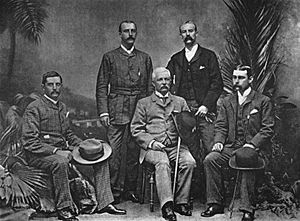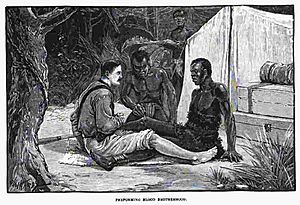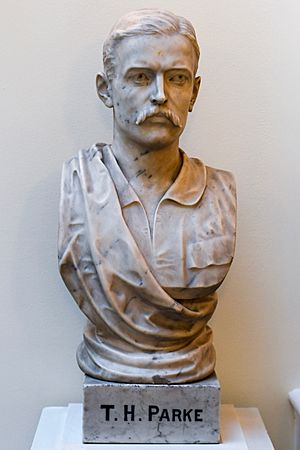Thomas Heazle Parke facts for kids
Quick facts for kids
Thomas Heazle Parke
|
|
|---|---|

Thomas Heazle Parke by Herbert Rose Barraud
|
|
| Born | 27 November 1857 Kilmore, County Roscommon, Ireland |
| Died | 11 September 1893 (aged 35) Ardrishaig, Argyllshire, Scotland |
| Buried |
Drumsna, County Roscommon, Ireland
|
| Allegiance | United Kingdom |
| Service/ |
|
| Rank | Surgeon-major |
| Unit | Army Medical Services |
| Other work |
|
Thomas Heazle Parke (1857–1893) was an Irish doctor and British Army officer. He was also an author and explorer. Parke became famous for his important medical work during the Emin Pasha Relief Expedition in Africa.
Contents
Early Life and Education
Thomas Heazle Parke was born on November 27, 1857. His home was Clogher House in Kilmore, County Roscommon, Ireland. He grew up in Carrick-on-Shannon, County Leitrim.
He studied medicine at the Royal College of Surgeons in Ireland in Dublin. Parke finished his studies in 1878. In 1879, he became a registered doctor. He first worked in Ballybay, then as a surgeon in Bath, Somerset.
Military Career and Adventures
Parke joined the British Army Medical Services in February 1881. His first assignment was in Egypt in 1882. This was during the end of the ʻUrabi revolt.
Treating Soldiers in Egypt
Parke was a senior medical officer at a field hospital near Cairo. He treated soldiers injured in battle. He also helped many troops suffering from a serious cholera outbreak. This disease affected many British soldiers there.
In late 1883, Parke returned to Ireland. He was stationed in Dundalk with the 16th The Queen's Lancers.
The Nile Expedition
Parke went back to Egypt in 1884. He joined the Nile Expedition. This group was sent to help General Charles George Gordon. Gordon was trapped in Khartoum by rebels. Sadly, the expedition arrived too late, and Gordon was killed. Parke later wrote about this sad event in a journal article.
After this expedition, Parke stayed in Alexandria for a few years. He even started fox hunting there! He became the leader of the Alexandria Hunt Club.
Emin Pasha Relief Expedition

In January 1887, Parke was asked to join a new adventure. This was the Emin Pasha Relief Expedition. It was led by the famous explorer Henry Morton Stanley. The goal was to find Emin Pasha, an Egyptian leader. He was cut off by rebel forces in Africa.
Parke first joined the expedition in Cairo. On February 25, 1887, the group set off from Zanzibar. They traveled west towards the Congo region.
Challenges in the Rainforest
The expedition lasted three years. It was very difficult. The group of 812 men faced many problems. They had poor planning and leadership. The rainforest was much bigger than Stanley expected. Many members of the group suffered from hunger and sickness.
Parke, as the doctor, saved many lives. He helped Stanley himself, who was very sick with stomach pain and a serious infection. Stanley praised Parke's care, calling him "patient, cheerful and gentle." Parke also treated Arthur Jephson for fever. He nursed Robert H. Nelson through starvation.
A Heroic Act
After a conflict with local people, William Grant Stairs was wounded by a poisoned arrow. Parke bravely saved his life. He sucked the poison out of the arrow wound. This shows how dedicated he was to helping others.
Later Life and Recognition
After returning from Africa, Parke received many honors. He was given a special award from the Royal College of Surgeons in Ireland. He also received gold medals from the British Medical Association and the Royal Geographical Society.
He wrote several books about his travels. These included My Personal Experiences in Equatorial Africa (1891) and A Guide to Health in Africa.
His Final Days
In August 1893, Parke visited a friend in Ardrishaig, Scotland. He sadly died there on August 11, 1893. It is thought he had a seizure.
His coffin was brought back to Ireland. He received a military funeral in Dublin. Parke was buried near his birthplace in Drumsna, County Roscommon.
Honors and Legacy
A bronze statue of Thomas Heazle Parke stands in Dublin. It is on Merrion Street, outside the Natural History Museum.
On the statue's base, there is a bronze plaque. It shows the moment Parke saved Captain William G. Stairs' life. He is also remembered with a bust in the Royal College of Surgeons in Ireland.




